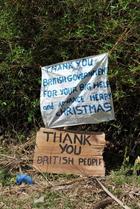Junglies back in the jungle
Article by Lieutenant Aaron Cross Royal Navy
‘It’s been decades since the Junglies were in the Far East’, observed one Commando Helicopter Force veteran of the 1960’s Indonesian Confrontation. As we sat on Borneo’s Baleh River, I could not have guessed we would, 8 months later, be facing the same flying challenges held by mountainous jungle terrain our fellow ‘Junglies’ the name given to CHF had half a lifetime ago.
All Commando Helicopter Force officers and ratings know something about Borneo and our Force’s service there. We know we served well, at a time when helicopter operations were fraught with difficulty – just one engine; no instrument flying or night vision capability; no over-the-horizon communications; and unreliable meteorological forecasting conspired to force a Wessex pilot to rely on his Junglie cunning and nothing more. We know it is where we earned our moniker ‘the Junglies’ and that there we set the tone for operations in Iraq and Afghanistan, through the Falklands, Northern Ireland and Bosnia.
But it was in the pursuit of further, first-hand knowledge that a number of Junglie personnel set out to visit Borneo, in March 2013. We first paid our respects at the Limbang memorial, the location of one of 42 Commando’s fiercest battles and were both humbled and surprised by the welcome we received from the locals following our 50 year absence. We then travelled further inland by road and river to Nanga Gaat – the fabled Junglie outpost as close to the Indonesian border as British Forces dared to venture. As the memorial stone we had only seen in grainy photographs appeared in the distance, a sense that we Junglies were returning home was heightened by the reminiscing of the veterans we had in company. On leaving, I remember contrasting the experiences of my current generation of Junglie pilots in the Afghan desert with the recollections of the original Nanga Gaat Junglies.
Fast-forward to November, and the Borneo team had dispersed to locations various, including back to Afghanistan; on to the Merlin training squadron at RAF Benson or the Defence Academy, Shrivenham; even to retirement and Central America in one case. Two pilots, however, remained at immediate readiness to deploy anywhere on the globe, onboard HMS Illustrious. Lieutenant Chris Mason and I shared in the worldwide shock at the destruction left in the wake of Typhoon Haiyan as it tore through the Philippines. As we began steaming east, we realised that perhaps we should have listened more closely in Borneo to the tales of derring-do, as we would soon be operating our Sea Kings in the heat, humidity and humbling need of the Philippine archipelago.
The devastation we encountered was matched only by the remoteness of some of the islands most in need. Infrastructure for the supply of food and other supplies is simply fishing boats and other small craft – a concerning number of which lay capsized, impotently displaying their hulls skyward. We were evidently going to need every ounce of power and manoeuvrability our Sea Kings could offer when delivering water, food, medicine and building supplies to beaches, mountainsides and jungle clearings. We were to become the custodians of life-changing aid for the crucial ‘final mile’ of the long supply chain to families and communities, who would have otherwise been so unfortunate as to be beyond the reach of conventional means of disaster relief.
As of 9 December, HMS Illustrious seven embarked helicopters have collectively amassed many flying hours ferrying people, equipment and under slung loads to and from shore, aiding in the region of 15,000 people, delivered 142 tonnes of food, and 186 disaster relief packs, containing tools and supplies.
They distributed over 10 cubic tonnes of drinking water to islands whose supply has been cut off or contaminated; 15,869 bales of tarpaulin – enough to re-roof almost 8,000 homes, and 154 tonnes of bespoke loads containing reconstruction materials, clothes, blankets, electrical generators, and boat repair kits. Altogether 671 pallets were flown off the ship in 363 sorties.
Photos: Igbon Island, Philippines. PO(Phot) Ray Jones









